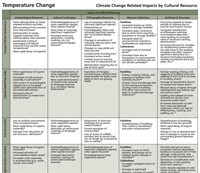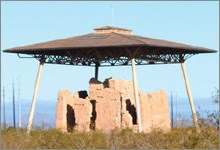

Climate change impacts are being observed throughout the country, both in coastal zones and in the interior. Cultural resources are vulnerable to dramatic and well-publicized effects of climate change, such as sea level rise or storm surges. Evidence from across the NPS is beginning to indicate they are also vulnerable to other, longer-running processes, such as the impact of more freeze/thaw cycles on stone materials or more rapid wetting and drying cycles on adobe buildings, and the loss of traditional knowledge and lifeways. The impacts table is a first step in identifying this broad range of impacts so that all of them can be included in stewardship practices. Given the diversity and uncertainty of climate change, this table cannot be exhaustive; other impacts and information such as thresholds will be identified as climate change develops. However, it can be used as a guide for identified impacts and motivation for continued research, monitoring, and understanding of all effects of climate change.
Purpose and Scope
The purpose of the impacts table is to succinctly describe how different manifestations of climate change will affect different types of cultural resources. The table is organized by major measurable trends of climate change, such as temperature and precipitation. Rows of the table are observable phenomena of these trends; in other words- how these trends will be felt and experienced. These phenomena are the forces to which cultural resources are being or will be exposed. Each entry within the table is an example of how a cultural resource is being or may be affected by those forces, also known as its sensitivity. The table does not include time frame or threshold information, such as when a given resource will begin to show damage from climate change stresses. In most cases, this information does not yet exist and is an important point for future research. While this table is designed to support resource managers and planners within the NPS, the resource types and associated impacts reach beyond the boundaries of parks and information throughout the table is broadly applicable to much cultural heritage around the world.

Last updated: July 21, 2016
